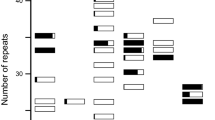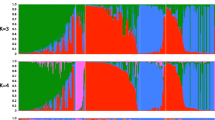Summary
The progeny of paired samples of Hordeum vulgare L. and Hordeum spontaneum C. Koch, collected from Jordan's xeric region was used in this study. Statistical analyses of seven easily measured morphometric traits were used to elucidate the relationships and distances between populations of both species, to detect any ecogeographical races, and to study the interrelationships and adjustments in the morphometric traits under study. Flag leaf area and plant height were the two most important discriminating variables which totally separated Hordeum vulgare from Hordeum spontaneum and accounted for 85.3% of total phenotypic variance in the collection. Cluster analysis indicated that the level of divergence among populations of both species was considerably different. Populations of Hordeum vulgare clustered at a maximum Euclidean distance of 2.08, while the maximum distance at which populations of Hordeum spontaneum clustered was 1.49. Three ecotypes each of Hordeum vulgare and Hordeum spontaneum were identified. These ecotypes corresponded to the environmental range of the collection sites. The interrelationships between the seven morphometric traits were adjusted in different ways as revealed by the principal components analysis. Sampling from the different clusters identified in this analysis is expected to increase the allelic diversity for selection and breeding purposes.
Similar content being viewed by others
References
Allard RW, Kannenberg LW (1967) Population studies in predominantly self-pollinated species. XI. Genetic diversity among the members of the Festuca microstachys complex. Evolution 22:517–528
Briggs KG, Shebiski L (1972) An application of factor analysis to some breadmaking quality data. Crop Sci 12:44–46
Brody T (1983) Patterns of trait variation in the diploid wheat species (Triticum-Aegilops) and the tetraploid species (Triticum dicoccoides). Plant Syst Evol 143:257–275
Brown A, Zohary D, Nevo E (1977) Outcrossing rates and heterozygosity in natural populations of Hordeum spontaneum in Israel. Heredity 41:49–62
Brown A, Nevo E, Zohary D, Dagan O (1978) Genetic variation in natural population of wild barly Hordeum spontaneum. Genetica 49:97–108
Ceccarrelli S (1984) Utilization of barley landraces and Hordeum spontaneum in barley breeding for dry areas at ICARDA. Rachis 3:8–11
Chang Te-Tzu (1985) Principles of genetic conservation. Iowa State J Res 59:325–348
Damania AB, Jackson MT (1986) An application of factor analysis to morphological data of wheat and barley landraces from the Bheri valley, Nepal. Rachis 5:25–30
Evans LT, Dunstone R (1970) Some physiological aspects of evolution in wheat. Aust J Biol Sci 23:725–741
Falconer DS (1981) Introduction to quantitative genetics, 2nd edn. Longman, New York London, 340 pp
Frankel O, Soule M (1981) Conservation and evolution. Cambridge University Press, Cambridge
Freeman GE, Dowker BD (1973) The analysis of variation within and between genotypes and environments. Heridity 30:97–110
Giles BE (1984) A comparison between quantitative and biochemical variation in the wild barley Hordeum murinum. Evolution 38:34–41
Giles BE, Edwards KJR (1983) Quantitative variation within and between populations of the wild barley Hordeum murinum. Heredity 51:325–333
Harlan JR, Zohary D (1966) Distribution of wild wheats and barley. Science 153:1074–1080
Jaradat AA (1989) Diversity within and between populations of two sympatrically distributed Hordeum species in Jordan. Theor Appl Genet 78:653–656
Jaradat AA, Jaradat TT, Jana S, Srivastava JP (1987) Diversity for quantitative characters in Jordanian landraces of barley. Barley Genet 5:109–117
MSTAT (1987) Microcomputer statistical program. Michigan State University, East Lansing
Nevo E, Beiles A, Gutterman Y, Storch N, Kaplan D (1984) Genetic resources of wild cereals in Israel and vicinity. II. Phenotypic variation within and between populations of wild barley, Hordeum spontaneum. Euphytica 33:737–756
Nevo E, Beiles A, Zohary D (1986) Genetic resources of wild barley in the Near East: Structure, evolution and application in breeding. Biol J Lin Soc 27:355–380
Plucknett D, Smith N, Williams JT, Murthi NA (1983) Crop germplasm conservation and developing countries. Science 220:163–169
Poiarkova H, Blum A (1983) Landraces of wheat from the northern Negev. Euphytica 32:257–271
Porceddu E, Scarascia Mugnoza GT (1983) Genetic variation in durum wheat. Proc 6th Int Wheat Genet symp pp 241–252
SAS Institute Inc. (1988) SAS user's guide: Statistics. SAS Institute, Cary
Snow L, Brody T (1984) Genetic variation of Hordeum spontaneum in Israel: Ecogeographical races detected by trait measurements. Plant Syst Evol 145:15–28
Sokal RR, Rohlf FJ (1981) Biometry, the principles and practice of statistics in biological research. W. H. Freeman, New York
Zohary D (1969) The progenitors of wheat and barley in relation to domestication and agricultural dispersal in the old world. In: Sucko PJ, Dimbleby CW (eds) The domestication and exploitation of plants and animals. G. Duckworth, London, pp 47–66
Author information
Authors and Affiliations
Additional information
Communicated by P.M.A. Tigerstedt
Rights and permissions
About this article
Cite this article
Jaradat, A.A. Ecotypes and genetic divergence among sympatrically distributed populations of Hordeum vulgare and Hordeum spontaneum from the xeric region of Jordan. Theoret. Appl. Genetics 78, 857–862 (1989). https://doi.org/10.1007/BF00266671
Received:
Accepted:
Issue Date:
DOI: https://doi.org/10.1007/BF00266671




